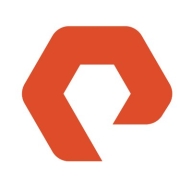


IBM FlashSystem and NetApp EF-Series All Flash Arrays are leading contenders in the all-flash storage market. While NetApp EF-Series has a slight edge due to advanced features, IBM FlashSystem often satisfies users with pricing and support.
Features: IBM FlashSystem is praised for strong data reduction capabilities, efficient performance optimization, and cost-effectiveness. NetApp EF-Series is noted for high-performance levels, robust data protection features, and advanced integration functionalities.
Room for Improvement: IBM FlashSystem users suggest improvements in scalability options, firmware updates, and user interface. NetApp EF-Series reviewers recommend enhancing integration support, reducing management complexity, and streamlining the deployment process.
Ease of Deployment and Customer Service: IBM FlashSystem is viewed as easy to deploy with solid customer support. NetApp EF-Series users find the deployment process straightforward but express mixed feelings about customer service experiences.
Pricing and ROI: IBM FlashSystem users often mention cost-effectiveness and good return on investment. NetApp EF-Series users recognize a higher initial setup cost but accept it due to long-term benefits and ROI satisfaction.



Pure Storage FlashArray//X is the world’s first enterprise-class, all-NVMe flash storage array. It represents a new class of storage – shared accelerated storage, which is a term coined by Gartner – that delivers major breakthroughs in performance, simplicity, and consolidation.
IBM FlashSystem products are enterprise computer data storage systems that store data on flash memory chips. Unlike storage systems that use standard solid-state drives, IBM FlashSystem products incorporate custom hardware based on technology from the 2012 acquisition of Texas Memory Systems. This hardware provides performance, reliability, and efficiency benefits versus competitive offerings.
The NetApp EF560 all-flash array is an all-SSD storage system for applications that demand extremely high levels of performance and reliability. Requiring just 2U of rack space, the EF560 all-flash array combines extreme IOPS, microsecond response times, and up to 12GBps of bandwidth with leading, enterprise-proven availability features.
We monitor all All-Flash Storage reviews to prevent fraudulent reviews and keep review quality high. We do not post reviews by company employees or direct competitors. We validate each review for authenticity via cross-reference with LinkedIn, and personal follow-up with the reviewer when necessary.